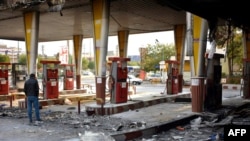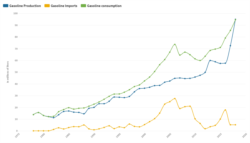The administration of President Hasan Rouhani increased fuel prices on November 15. The administration says it will distribute the extra government revenues to Iranian families who are eligible to receive cash subsidies.
But the claim by the government that it will not make a profit from the price hike may not be exactly true.In fact, the government may indirectly earn money from this move by reducing domestic demand and then exporting the excess fuel for hard currency earnings.
The announcement of the sudden increase in the price of gasoline sparked protests in dozens of Iranian cities and towns, which have continued for several days. Dozens of protesters have reportedly been killed in clashes with security forces and hundreds have been arrested.
The National Iranian Oil Products Distribution Company (NIOPDC) in a press release on November 15 reintroduced fuel rationing and the new fuel prices. According to the press release a monthly ration of 60 liters of gasoline has been allocated to each car owner at 15,000 rials per liter or 12 cents, showing a 50 percent increase. Any extra regular grade gasoline will be sold at 30,000 rials, 300 percent more than before. With nearly 300 percent increase super gasoline will be sold at 35,000 rials per liter. So one gallon of unrationed gas is now around 40 cents. That is still very cheap compared to most other countries.
In an interview with the state television on November 18, reported by Fars News Agency, Mohammad-Baqer Nobakht, the head of Iran's Planning and Budget Organization, said the administration has decided to distribute the estimated 300 billion rials saved by reducing fuel subsidies to 18 to 19 million families (around 60 million Iranians) that currently receive small cash subsidies.
"The administration of President Rouhani will not directly benefit from the increase in fuel prices but claims its budget revenues will increase as a result of a possible growth in gasoline exports," Dalga Khatinoglu, energy expert of the London-based Natural Gas World, told Radio Farda.
The reinstatement of U.S. sanctions against Iran in November 2018 has resulted in Iran's crude oil exports to drop below 400,000 barrels per day. Given the current circumstances the country's oil revenues next year is estimated to be in the region of 6 billion dollars, one tenth of its oil revenues in the previous year.
This might be true, but still the government can make a good profit. More expensive gasoline means less consumption and that means excess inventory for hard currency exports; something the government needs desperately.
The reintroduction of rationing is expected to help reduce domestic fuel consumption which will allow gasoline to be exported to offset the loss of revenues from crude oil exports. "Crude oil exports have dropped hugely but the country is still able to export oil products such as gas oil, fuel oil as well as liquified petroleum gas (LPG)," Khatinoglu said.
On 23 September Tasnim News quoted Seyed Ali Hosseini, managing director of Iran's Energy Exchange (IRENEX), as saying that each week between 400,000 to 500,000 tons of gasoline, gas oil and liquefied petroleum gas (LPG) is offered for sale by IRENEX, almost all of which is purchased by foreign buyers. "Sometimes buyers compete and increase the base price," he added.
Khatinoglu told Radio Farda that Iran is currently exporting fuel oil and gas oil to the United Arab Emirates, gasoline to Afghanistan, Iraq, Armenia and Pakistan and LPG to China, earning around half a billion dollars from these sales per month. "Iran will earn 2 to 2.5 billion dollars a year if gasoline exports continue in the same way," he said.
According to the International Energy Agency (IEA) estimates, Iran lost 26.6 billion dollars in liquid fuel subsidies in 2018 which is equal to nearly 45% of its total oil export revenues in the same year. In the current Iranian calendar year, the government is expected to earn 340 billion rials from gasoline sales while this figure could rise by 1,230 billion rials (roughly $10 billion) if the same amount of gasoline could be exported or sold at international prices.
The threefold hike in the price of unrationed gasoline may also reduce smuggling to neighboring countries where fuel prices can be up to ten times higher than fuel prices in Iran before the recent increase. There are no precise statistics on the volume of the fuel smuggled to countries such as Afghanistan and Pakistan. According to estimates 7 to 8 million liters of gasoline produced in Iran worth about 1.5 billion dollars is sold illegally outside its borders.
Iran has been hugely subsidizing fuel since the 1980s when the Iran-Iraq War (1980-89) and U.S. sanctions resulted in high inflation and the depreciation of its national currency. Despite payment of subsidies, the price of gasoline has risen from 10 rials in 1979 to 30,000 rials (current price of unrationed gasoline). However, converted to dollars, the price has significantly dropped. The reason is that in 1979 one dollar was worth 70 rials, while now it is 120,000.
So, if gasoline has risen 3,000 times in 40 years, the Iranian rial has depreciated nearly 8,000 times.
In short, gasoline in Iran, after the price increase is still much cheaper than it was in 1979. So the government wants to reduce the amount it sells cheap to domestic consumers and instead export it for much higher profits.




